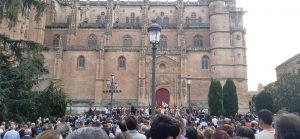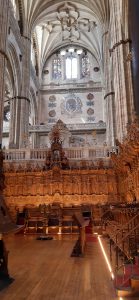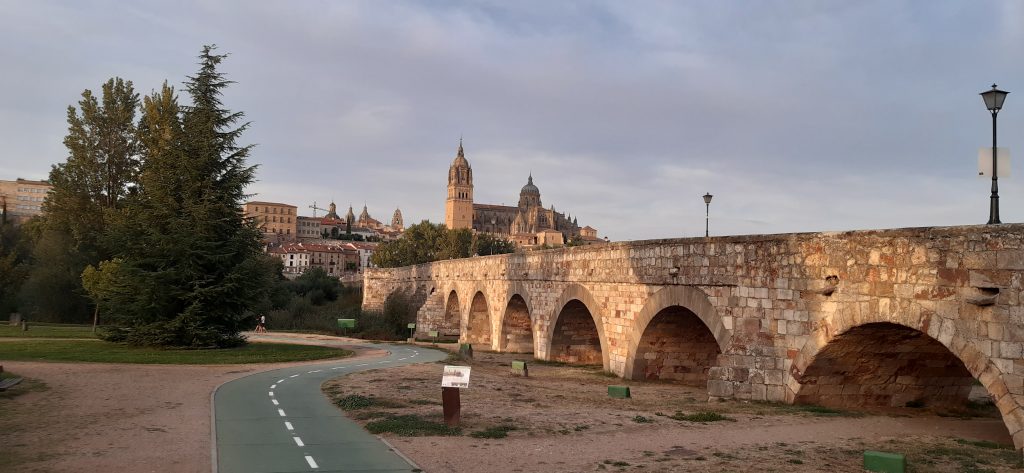Ha sido un mes muy interesante para mí. He empezado mis estudios aquí en Salamanca y puedo decir que el estilo de trabajo es muy diferente al que estoy acostumbrado. Por ejemplo, tengo clases en la mañana y la tarde, con bastante tiempo libre en el medio día para la siesta. Esto me parece increíble porque a veces termino las clases tarde, alrededor de las 19.30 o 20.30. Pero estoy gozando de este tiempo libre para comer tapas en los bares cerca de la facultad o para trabajar en biblioteca… ¡y dormir por supuesto!

View of the Cathedral during the medieval parade commemorating the ‘Siglo de Oro’ – the golden age of the Spanish Empire.
Recientemente visité la famosa Catedral de Salamanca. La construcción empezó en el siglo XII, poco después de la conquista de Salamanca por Alfonso VI en el año 1085. La Catedral es un edificio enorme y muy impresionante, sobre todo para una ciudad relativamente pequeña, de unas 140,000 personas.
Para un poco de contexto: En la edad media, España y Portugal fueron casi totalmente bajo el dominio de imperios musulmanes, basados en Andalucía, en esta época llamada Al-Ándalus. Un proceso de conquista por los reyes católicos del norte de la península eventualmente acabó con la presencia musulmana en España en 1492.
Uno de los héroes míticos de la reconquista de la península se llama ‘El Cid’. Según mi guía de tour, hay un crucifijo en la catedral llamado ‘Cristo de las Batallas’, del siglo XI, que pertenecía al Cid. Además, en tiempos de dificultad, la población de Salamanca antes preguntaba al Cristo de las Batallas para ayudarles. Me parece interesante como la religión sigue siendo un símbolo importante en la sociedad española, y El Cid es un carácter especial en la mitología sobre la formación de lo que hoy es España.
En la parte exterior de la catedral, hay otro símbolo un poco raro – ¡un astronauta! El astronauta está tallado al lado de la entrada de la catedral, y fue añadido por un artista durante una restauración en 1992. Es un desafío ver la pequeña figura del astronauta, y normalmente los turistas compiten para verlo primero. Hice esto con mis amigos, ¡pero por mala suerte perdí!

It’s been a very interesting month for me. I’ve begun my studies here in Salamanca and I can already say that the style of teaching of very different to what I’m used to. For example, I have classes in the mornings and evenings, with plenty of free time in the middle of the day for the siesta. What is incredible is that I sometimes finish the classes late, around 19.30 or 20.30. But I’m enjoying the extra free time, I use it to eat some tapas in the bars near my university department or to work in the library… and to sleep of course!
I recently visited the famous Cathedral of Salamanca. Its construction began in the 12th century, shortly after the conquest of Salamanca by Alfonso VI in 1085. The cathedral is an enormous and very impressive building, especially considering Salamanca is a relatively small city, with around 140,000 people.
Here’s a bit of context: In the Middle Ages, Spain and Portugal were almost entirely under the control of Muslim empires, based in Andalusia, at the time known as Al-Andalus. A long process of conquest by the catholic rulers from the north of the peninsula, eventually ended the Muslim presence in Spain by 1492.
One of the mythical heroes of the Reconquista is known as ‘El Cid’. And according to my tour guide, there’s a crucifix in the cathedral called ‘Christ of the Battles’, from the 11th century, which actually belonged to El Cid. Also, in times of hardship, the population of Salamanca used to ask the Christ of the Battles to spare them. I find it interesting how religion continues to be an important symbol in Spanish society, and El Cid is a special character in the mythology about the formation of what is now Spain.

In the exterior of the cathedral, there is another strange symbol – an astronaut! The astronaut is carved next to the entrance of the cathedral and was added by an artist during restoration in 1992. It’s a challenge to see the small figure of the astronaut, and normally tourists compete to see who spots it first. I did this with my friends, but unfortunately, I lost!
